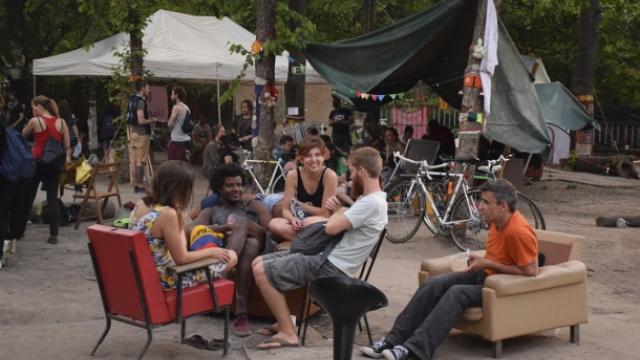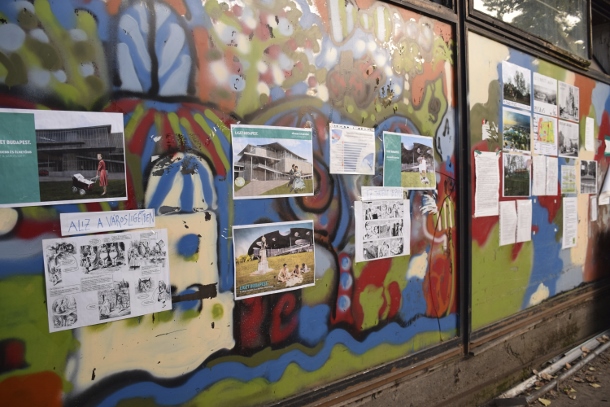
A small group of committed activists in Budapest have set up a camp in Városliget, or City Park, to stop the government from clearing trees for the construction of a new museum quarter.
In October of 2015, the Hungarian government approved an approximately $729 million master plan for erecting new buildings in the oldest and biggest public park in Budapest, which is also known as “the Liget.” The construction is part of a controversial park renewal plan called the Liget Budapest Project.
The project’s website boasts the transformation of the Liget into “a world standard, complex, family-friendly cultural and recreational park” bringing in annually an additional million tourists. However, the plan involves reconfiguring the park landscape for construction, including removing hundreds of trees and existing infrastructure — something many citizens do not support.
On March 17, when workers from Városliget Zrt., or the City Park Property Development Company — the business that is contracted to renovate the park and construct the buildings — began clearing trees in an area that is marked for the construction of the Hungarian House of Music, a group of 15 to 20 activists arrived to stop them. Determined to protect the trees and the park, the activists are still there 15 weeks later.
The group, now called Ligetvédők, or Park Protectors, occupied the space where trees were being cut and set up a camp to protest the project. The protest started small, but has grown to a group of about 10 full-time occupiers who are living in tents, 30 activists and organizers who help manage the camp and the protest, and close to a hundred additional supporters who visit on nights and weekends and join a wide variety of events. Their Facebook page now has over 10,300 likes.
According to organizers, the movement had struggled and lost some momentum a few weeks in because of disagreements in the camp. “Of course there will be conflict whenever there is a community, but we sat down and we talked about it and we solved it,” said Daniel Borbély, an activist who spends most days organizing at the park. They were able to regain traction and grow their base by mediating internal conflicts, holding general assemblies, organizing direct actions such as a naked photo shoot, renovating and occupying an abandoned building next to the camp, and hosting programs and concerts on the weekends.
For most of the activists, the main purpose is protecting the trees and the green spaces the park provides, but they are also enraged by the scale of the project. “I don’t oppose cutting some of the trees if it’s necessary,” said Borbély. “But it’s insane what’s happening here. That’s why I joined.”
Városliget Zrt. representatives said that the amount of green space will increase with the renovations and vehicular traffic would decrease. However, as part of the project the government committed to constructing several new buildings, including the Hungarian House of Music, City Park Theater, Museum of Ethnography, a bio-dome for the Budapest Zoo and a National Gallery. Some existing structures are also being renovated. With the Museum of Hungarian Agriculture; the Museum of Science, Technology and Transport; and the Museum of Fine Arts already occupying space in the park, the government is looking to turn the park into an elite museum quarter.
With green space already extremely limited in Budapest, many activists believe the Liget Budapest Project would fundamentally change the purpose and the atmosphere of the park. Gitta Nyáry, an activist living at the camp said the new buildings “would make it impossible to believe this is a park.”
Other Ligetvédők activists see the construction as an affront to democracy and an example of government power-grabbing because there was no real attempt to include the public in the decision to construct new buildings in the park. “I don’t agree that the government should do something when the people don’t want it,” said Csongor Kiripolszky, an activist who has stayed at the Liget since the second day of protest and is part of the communication group. “The government is doing this project without the public. This is my biggest problem. And of course it’s not okay for them to destroy the nature. But the first problem is it’s not democratic.”
There is evidence to support his claim. A survey by a public affairs research institution, Ipsos, found 75 percent of respondents in Budapest did not agree that new facilities should be established in City Park. Additionally, the survey found that 83 percent of respondents did not want the Hungarian National Gallery to be moved from the Budavár, or Buda Castle, to City Park, and 77 percent did not want government offices moved to the castle.
Currently, the Budapest History Museum and the National Hungarian Gallery are housed at the castle. Activists claim that Prime Minister Viktor Orbán, leader of the national conservative Fidesz party, wants to move exhibits from the castle so he can use it as his office and residence.
The scheme is not hard to imagine. The prestigious and historic Hungarian Buda Castle was first built in 1265 and served as the palace of Hungarian kings, so it would be the perfect setting — according to the protesters — for a pseudo-monarch of the 21st century. With his goal of creating an “illiberal democracy,” which has led to the rewriting of the constitution to secure power and hundreds of new laws that erode rights, democracy and civil liberties, Orbán has long been considered Hungary’s new dictator, both at home and abroad. A 2011 Transparency International report also found that the cozy relationship between the country’s political and business elites has effectively led to the Hungarian state being “captured by powerful interest groups.”
To correct the power imbalance, Ligetvédők activists are demanding the public be involved in the plans to renew the park. According to Borbély, “Our goal is to force the government to renew City Park without buildings and with public consensus.” Greenpeace activist Dorothy Taylor, who also lives in the park said, “the best outcome of the protest would be that the project would not be handled by the development corporation — it should be handled by the people.”
The group is committed to staying in the park until the government gives the public a say in the project. They have succeeded in halting the cutting of trees, at least for the time being. But how the government or the development company in charge of the park renovations will respond, remains to be seen.
Borbély said the short-term goal is still “to not get evicted,” but activists are also looking to the future. “The group agrees in creating a community space,” Nyáry said. “I don’t know if they started with this purpose, but now it is a common purpose.” She hopes for a “space to create — painting, theater, or whatever,” and believes, “the community garden is also really important because people are living in the city and they don’t have a garden.” Borbély and others would like to see the creation of an eco-friendly community center that could also serve as a place “to foster social movements.”
Taylor has bigger dreams. “The movement is a little seed,” she said. “We are planting it, and I hope we will grow into a big, colorful, lovely planet, not just for Hungarians, but for all people on the planet to harvest, smell and to taste the fruits.”
Originally published by Waging Nonviolence

3 WAYS TO SHOW YOUR SUPPORT
- Log in to post comments












